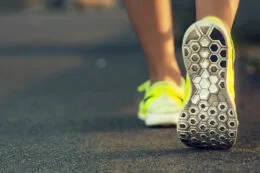Breaking in Your New Running Shoes

Running is an exhilarating sport that tantalizes the senses and invigorates the soul. However, for runners, both novice and seasoned, the idea of slipping into a fresh pair of running shoes often comes with mixed emotions—excitement for a new beginning tempered by the caution of avoiding discomfort.
How to Break In Running Shoes
Before you set your sights on the horizon, it’s important to recognize that even the perfect pair of shoes needs time to adapt to your feet. Short, low-intensity runs are the ideal way to inaugurate your new sneakers. This approach minimizes pressure points and gradually invites the shoes to contour to your unique foot shape.
- Begin with brief jogs or walks, keeping them to a maximum of 20-30 minutes at a comfortable pace.
- Opt for softer surfaces like tracks, trails, or treadmills to lessen the impact on both your shoes and feet.
- Stay mindful of how your feet and shoes are responding during these initial outings—any signs of discomfort should be addressed promptly.
- Balance out your runs between hard and soft surfaces to encourage an even break-in process.
- Always wear moisture-wicking and snug-fitting socks when breaking in new running shoes.
- If you have specific running socks you prefer, ensure to wear them every time to maintain consistency.
Adopting these initial steps when introducing your feet to new running shoes will help to construct a foundation of comfort and longevity in your running journey.
How Long to Break In Running Shoes Before a Marathon
If the marathon distance is calling your name, breaking in running shoes becomes not a casual affair but a critical component of your success. The marathon does not forgive the ill-prepared shoe; thus, knowing the timeline and technique for preparing your sneakers is essential.
The rule of thumb suggests coaxing your shoes through at least 50-70 miles before the big race. This ensures ample time for the shoes to mature into the cushioned, supportive dynamos you need them to be on race day.
- Begin with several short runs, then incrementally tack on the mileage.
- Use the 50-70 mile break-in gauge as a benchmark—a more personalized approach might be necessary depending on your running style and the shoe’s materials.
To foster a symbiotic relationship between your feet, body, and new shoes, it’s helpful to keep your old pair in the rotation. This gentle introduction spares both your body and your new shoes from undue stress.
- Weave in days where your old pair takes the lead, allowing your feet to remember the familiar while getting to know the new.
- Experiment with different pacing and intervals to see how the shoes respond under varying conditions.
Monitoring the condition of your shoes throughout the break-in process is critical, especially with an eye towards fit and cushioning. Any concerns need addressing well before you toe the starting line. Pay attention to the snugness of the fit, and ensure there’s appropriate room for toe movement.
The journey to a comfortable marathon with your new running shoes requires patience, awareness, and a proactive approach. Remember, the goal is not just to “get used” to your shoes but to ensure they become a seamless extension of your feet—providing support, comfort, and peak performance when you need it most. Pay careful attention to how your feet feel during each run, and make necessary adjustments to your breaking-in process. The time it takes can vary from runner to runner, but typically spans between 20 to 30 miles of running. Trust your instincts and be mindful of any discomfort that doesn’t resolve with time, as it could signal the need for a different pair of shoes or a customized fit.
Happy running!
Related
Other Treadmill Reviews:
- Test HomePage
- NordicTrack Commercial X14i
- Echelon Stride
- NordicTrack C 590 Pro
- NordicTrack T 7.5 S - Pros & Cons (2024)
- Sole TD80 Treadmill Desk
- NordicTrack Commercial X11i
- NordicTrack T 8.5 S - Pros & Cons (2024)
- Horizon Elite T5
- Exerpeutic TF1000
- NordicTrack T 6.5 S - Pros & Cons (2024)
- ProForm Sport 5.0
- ProForm Premier 900
- ProForm ZT6
- NordicTrack FreeStride Trainer FS5i (Discontinued)
- Bowflex Max Trainer M5
- BowFlex TreadClimber TC100
- ProForm Power 795
- ProForm Sport 7.0
- NordicTrack Incline Trainer X15i
- NordicTrack C 1650 Treadmill
- Horizon Elite T9
- Official Boston Marathon Treadmill 4.0
- NordicTrack Treadmill Desk
- NordicTrack C 1630 Pro
- NordicTrack C 970 PRO
- Bowflex TC20 TreadClimber

